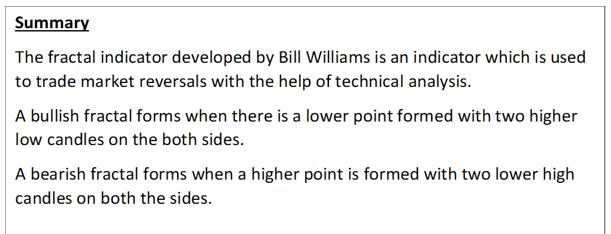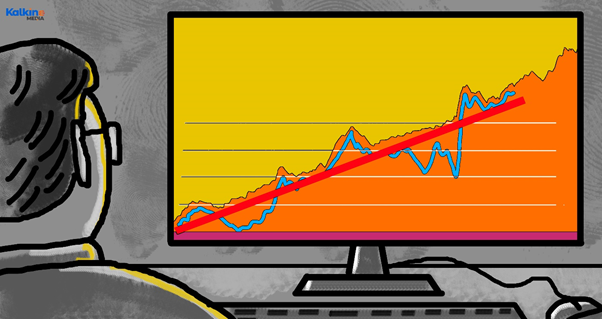What do you mean by the Fractal Indicator?
The fractal indicator depends on a fundamental value design that is often seen in financial markets. Outside of exchanging, a fractal is a typical mathematical example that is repeated on different time frames. From this idea, the fractal pointer was concocted. The indicator secludes possible defining moments on a value graph. It then, at that point, attracts bolts to show the presence of an example. The bullish fractal design indicates the cost could move higher. A bearish fractal suggests the price could move lower. Bullish fractals are set apart by a down arrow, and bearish fractals are set apart by an up arrow.
Bill Williams introduced the fractal marker in his book, "Exchanging Chaos," noticing that his thought for the pointer follows its beginnings to the numerical hypothesis. In mathematics, fractals are fundamentally any repeating design. The reason for the fractal arrow is that you can identify, and possibly benefit from, repeating examples of value development that happen across different exchanging periods (hourly, 4-hour, every day, week after week, and so on).

Understanding the Fractal Indicator
Utilizing the fractal indicator is the acknowledgment of an example in the value activity of an exchanged security. When the sample is perceived, brokers would then be able to purchase or sell, contingent upon whether the fractal marker is bullish or bearish, hoping to benefit from a market inversion.
The fractal design, which can be distinguished on both bar graphs and candle outlines, is contained the value activity that happens throughout five candles. Contingent upon what graphing time a broker is utilizing, the full measure of time needed to shape a fractal design fluctuates. For a dealer using the hourly diagram, a fractal example can frame in five hours – while a merchant who compromises the simple outlines will see fractal designs that structure throughout five days.

Source: Copyright © 2021 Kalkine Media
One of the benefits of Williams' fractal pointer is that it is generally simple to spot on an outline. The fractal design comprises five progressive candles, with the centre (third) candle addressing the most elevated high or least low of the gathering of five candles.
- The essential standards for the fractal design are as per the following:
A candle (which will be the third, or centre, candle in a fractal structure) addresses a high point (with a bearish fractal) or a depressed spot (with a bullish fractal) in the value activity development of security.
A bearish fractal design happens when both of the two candles that go before a high point candle on the diagram, and the two candles that follow the high point accomplished by the third candle in the example, show lower highs (reference the above picture).
A bullish fractal design happens when both of the two candles that go before a depressed spot candle on the diagram, and the two candles that follow the low, show higher lows.
- A substitute method to comprehend the fractal design is:
A bearish fractal design demonstrates a market inversion to the drawback, structures when every one of three progressive candles shows cost achieving a higher high, trailed by two candles showing value activity with a lower high than the high of the former candle.
A bullish fractal design demonstrates a market inversion to the potential gain, structures when every one of three progressive candles show value moving to a lower low, trailed by two candles showing value activity with a higher low than the low of the previous candle.
The fractal design uncovers a "V" or "U" moulded base or top framing in a market – albeit the example is seldom as entirely perfect and even as the one displayed in the picture above.
Such an example of value activity may show a market inversion – either a past improving business sector step by step going over to the disadvantage, or a past down-trending market going to the potential gain.
At any rate, a fractal design is deciphered as distinguishing somewhere around an impermanent degree of value support (bullish fractal) or value obstruction (bearish fractal).
Merchants often see a fractal design according to other specialized help/opposition markers; for example, every day rotate focuses on assessing the strength or plausible unwavering quality of the fractal pointer's sign of a pattern inversion.
For instance, if the high place of a bearish fractal design agrees with a Fibonacci retracement level or moving average level that additionally distinguishes that value point as an opposition level, then, at that point, the fractal pointer would be deciphered as being more dependable – bound to be a specific marker of a market inversion.
Calculation:
- Confine a high/low (N) point on the diagram.
- There is a potential example if there are two lower highs to one side of the great or two higher lows to one side of the low (N-2 and N-1). The example needs two different bars on the option to affirm.
- A bearish fractal is finished on the off chance that two lower highs happen after the highs (N+1 and N+2). If two higher lows happen after the low, a bullish fractal is finished.
Frequently Asked Questions
- What are the advantages and disadvantages of the Fractal indicator?
The fractal pointer offers the benefits of providing brokers effectively recognizable market passage focuses (at the end of the fifth candle in the example). Similarly, simple to-spot value focuses on stop-misfortune orders.
With a bearish fractal design, a broker undercuts and afterward may put in a stop-loss request simply over the most elevated high accomplished in the fractal structure. With a bullish fractal design, a broker purchases at the end of the fifth candle and may then put their stop-loss request just beneath the least low of the five-candle fractal design.
A weakness of compromising the fractal marker is how fractal designs often take place in the conventional course of value activity development – in this manner, the pointer is inclined to give brokers bogus signs. That is why not many dealers depend entirely on the fractal marker for exchanging signals rather than utilizing it related to other specialized pointers.
Another burden of exchanging the fractal design is that it gives not exactly ideal market section focuses. For instance, starting a purchase exchange at the end of the fifth candle in a bullish fractal example may bring about a merchant getting tied up with the market at a value level that is considerably higher than the market low.
Besides, assuming the broker submits a stop-loss request beneath the low of the fractal design, the exchange's potential loss might be a financial sum that is unsatisfactorily high.
 Please wait processing your request...
Please wait processing your request...